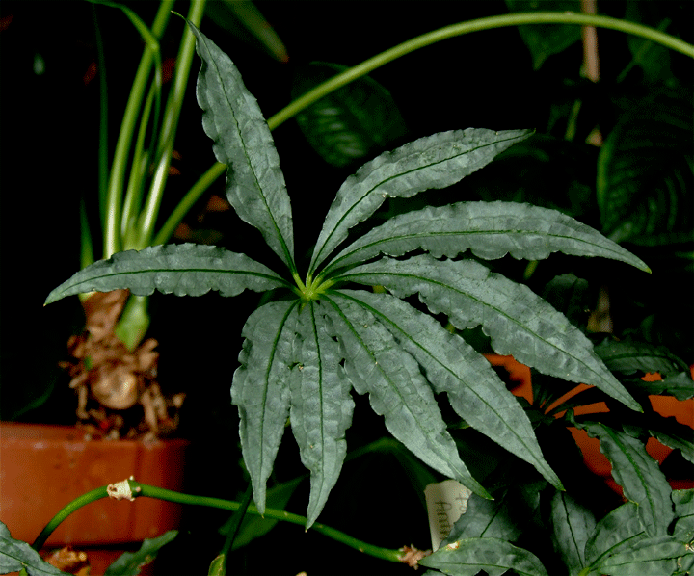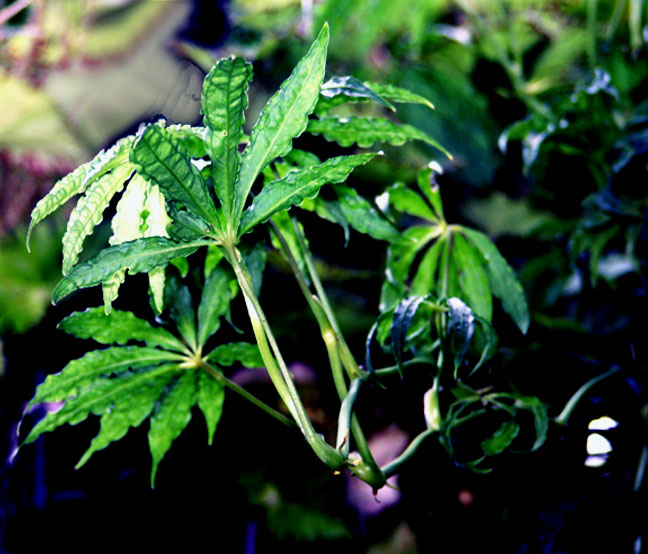![]()
Aroids and other genera in the Collection
Take the Tour Now?
Orchids
The
Exotic Rainforest
Plants in
the Exotic Rainforest Collection
The images on this website are copyright protected. Please contact us before any reuse.
Detailed information on Growing Anthurium Species
Click this Link
We do not sell Anthurium or seeds. The Exotic
Rainforest is a private botanical garden.
Within our collection we have many species of Anthurium.
If you are seeking other photos,
click this link:
Anthurium polyschistum
R.E. Schult. & Idrobo

Anthurium
polyschistum
R.E. Schult. & Idrobo
An Anthurium that grows like a vine!
An Anthurium that grows like a vine!
Janice and I had the opportunity to spend some time with
aroid botanist Dr. Tom Croat at the
Missouri Botanical Garden in St. Louis during October, 2006. In addition to the enormous Climatron which is quite literally a rain forest under glass, the garden
maintains several research greenhouses where rare and exotic plants are studied
and type specimens are housed.
These research greenhouses are not open to the public however we were given a tour
by Dr. Croat. While I was busily snapping photos of
anything that interested me (everything) Janice was looking
at a very unusual Anthurium that grows like a vine, Anthurium
polyschistum. This strange little Anthurium sp. is often
terrestrial and runs across the jungle
floor like any other rain forest vine until it grabs hold of any tree in to
climb.
Anthurium polyschistum
grows as a terrestrial, an appressed epiphytic climber growing close to
the host as well as a hemiepiphytic
aroid. The semi-rare
Anthurium polyschistum is unusual in collections and grows from the ground up the sides
of trees or it's seeds may be deposited by a bird on the tree and grow
down toward the ground where it then deposits roots. The very unusually
shaped A. polychistum normally has
5 to 9 lleaflets on each leaf
blade. The blue/gray blades are thin and only slightly
glossy. They actually appear to be more like a
palm than an Anthurium due to what is known botanically as "palmatisect"
leaves. These leaflets are cut to the base of the leaf and possess
undulated margins. As a result of the growth form the Anthurium belongs
to section Dactylophyllium.
This delicate Anthurium is
found in Ecuador, Peru, Bolivia, Brazil and Colombia. In Colombia it can be found in the
Amazon River watershed along the Loretoyacu River at an elevation
above sea level of 100 meters (approximately 300 feet). Dr. Croat
advised in a recent personal email Anthurium polychistum
"is restricted to lowland
Amazonia".
He also
 noted the plant is not completely
botanically described. The palmately divided leaves are quite
thin and the plant wilts quickly when the vine is cut. However, if kept
in a very humid environment Anthurium polychistum will begin to
root relatively quickly from the numerous root systems found along the
stem.
noted the plant is not completely
botanically described. The palmately divided leaves are quite
thin and the plant wilts quickly when the vine is cut. However, if kept
in a very humid environment Anthurium polychistum will begin to
root relatively quickly from the numerous root systems found along the
stem.
 noted the plant is not completely
botanically described. The palmately divided leaves are quite
thin and the plant wilts quickly when the vine is cut. However, if kept
in a very humid environment Anthurium polychistum will begin to
root relatively quickly from the numerous root systems found along the
stem.
noted the plant is not completely
botanically described. The palmately divided leaves are quite
thin and the plant wilts quickly when the vine is cut. However, if kept
in a very humid environment Anthurium polychistum will begin to
root relatively quickly from the numerous root systems found along the
stem.
The stem's Internodes are dark green and semi-glossy
tending towards gray. The petioles are sharply "D" shaped
but may also be canaliculate with the shape of a "C". A close
examination of the petiole will reveal it is deeply sulcate.
Sulcate
indicates either a canal known as a sulcus or having numerous fine
parallel grooves. The cataphylls
persist semi intact on the upper nodes. The leaf blades are thin
and only slightly glossy on the adaxial surface (upper) but both matte
and paler beneath. The midrib is slightly raised on both both
sides; If you examine the primary lateral veins you'll notice they
are slightly sunken on the adaxial surface but slightly raised below.
Tertiary or minor leaf veins are very difficult to observe.
Anthurium polyschistum like all Anthurium species reproduces via the production of
an inflorescence and that inflorescence is supported by
a stalk known as the peduncle. When an Anthurium is "in
flower" the reference is to the tiny bisexual flowers which
contain male, female, and sterile
male
parts that grow on the spadix
at the center of the inflorescence. The
spathe of an aroid is not a "flower" but instead is a modified leaf
and in Anthurium polyschistum is spathe that is green and
quite narrow with a green spadix.
Anthurium differ from Philodendron species since all Anthurium produce perfect flowers containing both male and female organs while Philodendron produce imperfect flowers containing only a single sex. The tiny flowers containing both male and female sexual parts grow on the spadix at the center of the inflorescence. To help prevent self pollination nature has designed the female flowers to be receptive before the male portion of the flower produce their pollen so in most cases an insect must bring pollen from another plant. For more information on the sexual reproduction of any aroid click the pollination link below.
Anthurium differ from Philodendron species since all Anthurium produce perfect flowers containing both male and female organs while Philodendron produce imperfect flowers containing only a single sex. The tiny flowers containing both male and female sexual parts grow on the spadix at the center of the inflorescence. To help prevent self pollination nature has designed the female flowers to be receptive before the male portion of the flower produce their pollen so in most cases an insect must bring pollen from another plant. For more information on the sexual reproduction of any aroid click the pollination link below.
The Infructescence which
is produced when the plant is pollinated produces fruits that are violet
purple. The spadix at
its center of the inflorescence vaguely resembles an elongated pine
cone. The spadix is a spike on a thickened fleshy axis which
can produce tiny flowers.
Anthurium differ from
Philodendron species since all Anthurium produce perfect
flowers containing both male and female organs while Philodendron
produce imperfect flowers containing only a single sex. When an
Anthurium is "in flower" the reference is to the tiny flowers
containing both male and female sexual parts that grow on the spadix at
the center of the inflorescence. To help prevent self pollination nature has
designed the female flowers to be receptive before the male portion of
the flower
produce their pollen so in most cases an insect must bring pollen from
another plant.
Once the female portion of the flowers on the spadix are ready to reproduce during
anthesis (sexual reproduction) they must be pollinated by a beetle that
is a member of the genus Cyclocephala which transfers pollen from a
specimen currently at male anthesis to a specimen that is receptive
at female anthesis.
A link to information from aroid expert Julius Boos can be found
near the bottom of this page if you wish to learn how aroids are
pollinated in nature. If pollinated the flowers will produce berries
containing seeds. The
berries are then eaten by birds and other rain forest animal
species that spread them among the forest in their droppings.
We have the specimen
climbing a tall totem in filtered light in soil that is very fast
draining mixed with orchid potting media and Perlite™,
peat moss and cypress mulch. Botanical notes state the plant is found in shady areas
of the rain forest. Although not common, this species may
sometimes be available to collectors. Our specimen was
a gift from Dr. Croat and his assistant Emily Colletti.
Anthurium species are
known to be highly variable and not every leaf of every specimen will
always appear the same. Of curious note, Anthurium
polyschistum bears a resemblance to Cannabis. This link explains in greater detail the
scientific principle of natural variation and morphogenesis within
aroids and other species.
Click here.
If
you love rare plants, would like to experience a rain forest without
traveling to South America, and have never been to the Missouri Botanical
Garden make a plan to visit. Plan a full day. I've been fortunate
enough to spend time in several South American rain forests and this is
absolutely the next best thing. A link to the MOBOT website can be
found on our "Links" page which can be found at the bottom of the
homepage of this website. Take a camera!
Join the
International Aroid Society:
http://www.exoticrainforest.com/Join%20IAS.html
If you are seeking information on other rare
species, click on "Aroids and other genera in the Collection" at the top and look for
the
